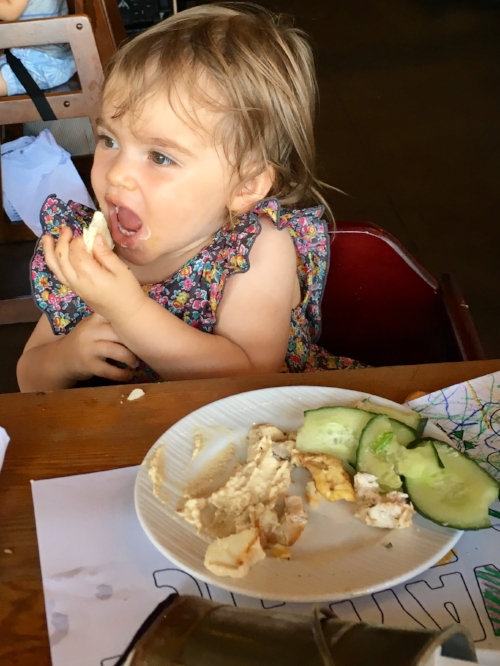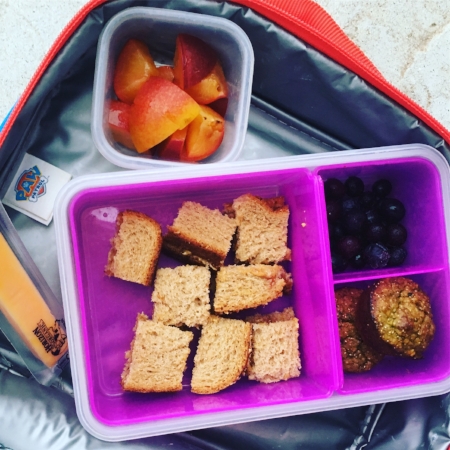Age-appropriate Portions for Toddlers (and Moms)
This post is by Rachel Rothman, MS, RD, and is the third post in the three-part blog series about introducing solids to your little one. Rachel is a mom to a toddler, a pediatric dietitian and instructor of “Introduction to Solids” and “Nutrition for Toddlers and Preschoolers” at the San Diego Breastfeeding Center. Join us for the next Nutrition for Toddlers and Preschoolers class on October 29th at 10:00am. More information and registration can be found here.
In case you missed it, I discussed the feeding relationship in my previous two posts, and these may be summarized using the division of responsibility. Parents are responsible for the “what, when, and where of feeding; children are responsible for the how much and whether of eating” [1]. In this third post we discuss age appropriate serving sizes – however, as with all nutrition advice, sustainably learning the behaviors associated with this division of responsibility will be as important, if not more influential, than simply choosing specific serving size, as all of our young ones progress at slightly different paces and individual ways.
Most of the food we eat- and the nutrient measurements we rely on – use the idea of serving sizes. But what does a serving look like?
Adults struggle with this because it’s hard to learn at home, and when we eat out, it’s nearly impossible to get consistent feedback. As children, most parents did not learn to react this way, and an age of abundant and convenient food has limited the effects of our natural impulses.
When we feed our children, many parents second-guess themselves and their children’s eating behaviors. Is my child eating enough? Is my child eating too much? Here are some helpful guidelines when it comes to your children and serving sizes, starting from the beginning, when first introducing solids.
Tips and guidelines when thinking about the appropriate serving size for your infant and toddler:
- Around 6-7 months, as your baby is first starting solids, it’s important to remember serving sizes are very small. If you are offering purees, you will want to start by offering 1-2 teaspoons, keeping in mind initially your baby may not take more than a small taste. You will most likely be advancing to 1-3 tablespoons as your baby moves toward 7-8 months.
- From 6 months to around 1 year, breast milk or a breastmilk substitute should still make up the majority of your baby’s calorie intake. Offer breast milk or a breastmilk substitute before solids, especially when starting out.
- All babies are different. Some babies love solids right off the bat and may take more than 2-3 tablespoons. That’s okay! It may take other babies some time to begin their solid intake and they may refuse for a while. That’s okay, too! The important thing is to continue to offer solids, but let your child decide whether he/she wants to eat.
A typical toddler breakfast: 2-3 tablespoons of yogurt, 1/4 cup fruit and 2-3 small pancakes (and it’s okay if they don’t finish the whole thing!).
-Around 8-11 months your baby continues to grow, so does his/her appetite. Solid intake may increase, but not by much. A full day’s worth of solids might be: ¼ cup of fruit, ¼ cup vegetables, 1-3 tablespoons protein and ¼ cup whole grains. A serving of vegetables, however, may still be closer to 2-3 tablespoons.
- After one year of age, baby’s growth slows (most babies triple their birth weight over the first year!). With a decrease in growth rate may also come a decrease in appetite. Do not be alarmed if intake decreases after one year of age. It’s most important to monitor your baby’s weight gain and growth.
Snacks and lunch packed for daycare: 1/2 peanut butter and jelly sandwich, blueberries, oat and spinach muffin, string cheese and nectarine slices.
Additionally, after one year of age, your toddler may be eating more meals and snacks throughout the day. When thinking about meals and snacks to serve, try to offer something from each food group. Meals should consist of a fruit or vegetable, carbohydrate and protein, while a snack might consist of a fruit and vegetable and a carbohydrate. Don’t be afraid to think outside the box and try new things. One of my daughter’s favorite on the go snacks is a mix of chick peas and green peas; a combination of protein and carbohydrates with a healthy mix of vitamins and minerals.
Stay positive! Picky eating behaviors often develop during this time and can persist as a phase many healthy kids go through. If you stay positive and dedicated to offering a broad variety of healthy, whole foods, you have the best chance of continuing to nourish your little one while accommodating their tastes and preferences.
To learn more about introducing solids to your little one, join me at the SDBFC in one of my Introduction to Solidsor Nutrition for Toddlers and Preschoolers classes. More information can be found here.
[1] Satter, Ellen M., Child of Mine: Feeding With Love and Good Sense, Bull Publishing Company; Revised edition (March 1, 2000) http://www.amazon.com/Child-Mine-Feeding-Revised-Updated/dp/0923521518
Rachel Rothman, MS, RD is a mom, pediatric dietitian, and instructor at the San Diego Breastfeeding Center. She lives in San Diego with her husband Ben and daughter Sydney.





